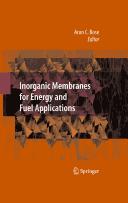| Listing 1 - 2 of 2 |
Sort by
|
Book
ISBN: 3030060853 3030060845 Year: 2019 Publisher: Cham : Springer International Publishing : Imprint: Springer,
Abstract | Keywords | Export | Availability | Bookmark
 Loading...
Loading...Choose an application
- Reference Manager
- EndNote
- RefWorks (Direct export to RefWorks)
This book presents the applications of ion-exchange materials in the chemical and food industries. It includes topics related to the application of ion exchange chromatography in water softening, purification and separation of chemicals, separation and purification of food products and catalysis. This title is a highly valuable source of knowledge on ion-exchange materials and their applications suitable for postgraduate students and researchers but also to industrial R&D specialists in chemistry, chemical, and biochemical technology. Additionally, this book will provide an in-depth knowledge of ion-exchange column and operations suitable for engineers and industrialists.
Food science. --- Chemical engineering. --- Chemistry, inorganic. --- Chemistry, Organic. --- Catalysis. --- Food Science. --- Industrial Chemistry/Chemical Engineering. --- Inorganic Chemistry. --- Organic Chemistry. --- Water Industry/Water Technologies. --- Inorganic ion exchange materials. --- Inorganic ion exchangers --- Ion exchange materials, Inorganic --- Chemistry, Inorganic --- Materials --- Activation (Chemistry) --- Chemistry, Physical and theoretical --- Surface chemistry --- Organic chemistry --- Chemistry --- Inorganic chemistry --- Inorganic compounds --- Chemistry, Industrial --- Engineering, Chemical --- Industrial chemistry --- Engineering --- Chemistry, Technical --- Metallurgy --- Science --- Food—Biotechnology. --- Inorganic chemistry. --- Organic chemistry. --- Water-supply. --- Availability, Water --- Water availability --- Water resources --- Natural resources --- Public utilities --- Water resources development --- Water utilities --- Food --- Biotechnology. --- Chemistry, Inorganic.

ISBN: 0387345248 1441922377 9786611810535 1281810533 0387345264 Year: 2009 Publisher: New York : Springer,
Abstract | Keywords | Export | Availability | Bookmark
 Loading...
Loading...Choose an application
- Reference Manager
- EndNote
- RefWorks (Direct export to RefWorks)
The study of inorganic membrane materials and processes is a rapidly expanding research interest area. This is due to the recognition that research results in recent years have created membrane-based technology modules with the potential to improve the cost, efficiency, and environmental performances of energy production systems beyond current benchmarks. This book documents progress in inorganic membranes, especially in advanced materials and novel separation concepts, with applications for cost-effective and environmentally-progressive energy production solutions. The book chapters address inorganic membranes on three transport mechanisms, i.e., mixed ion-electron conduction, solution-atomic diffusion, and size exclusion filtration of the permeate phase. Inorganic Membranes for Energy and Environmental Applications provides a single source reference for researchers contemplating continued advancement of inorganic membrane technology to novel capabilities for applications to future energy and fuel production systems and potentially, technology-based responses to address greenhouse gas emission concerns. This book is meant for scientists, engineers, industry R&D personnel, and graduate students engaged in the development, engineering scale-up, and applications of inorganic membrane materials and processes, and non-technical management staff delegated with programmatic and resource allocation decision authorities who need to know about state-of-the-art current inorganic membrane technology.
Membranes (Technology). --- Membranes (Technology) --- Inorganic ion exchange materials --- Ion-permeable membranes --- Gas separation membranes --- Hydrogen --- Oxygen --- Power resources --- Electric power production --- Chemical & Materials Engineering --- Engineering & Applied Sciences --- Chemical Engineering --- Ion-permeable membranes. --- Gas separation membranes. --- Electric power production. --- Power resources. --- Inorganic ion exchange materials. --- Inorganic ion exchangers --- Ion exchange materials, Inorganic --- Energy --- Energy resources --- Power supply --- Electric power generation --- Electricity generation --- Power production, Electric --- Ion exchange membranes --- Permeable membranes (Electrodialysis) --- Permselective membranes --- Artificial membranes --- Chemistry. --- Analytical chemistry. --- Inorganic chemistry. --- Electrochemistry. --- Chemical engineering. --- Energy industries. --- Materials science. --- Industrial Chemistry/Chemical Engineering. --- Analytical Chemistry. --- Energy Economics. --- Materials Science, general. --- Inorganic Chemistry. --- Chemistry, Inorganic --- Materials --- Natural resources --- Energy harvesting --- Energy industries --- Electric power systems --- Electrification --- Electrodes, Ion selective --- Electrodialysis --- Ion exchange --- Separation (Technology) --- Technology --- Analytical biochemistry. --- Materials. --- Chemistry, inorganic. --- Energy Policy, Economics and Management. --- Inorganic chemistry --- Chemistry --- Inorganic compounds --- Physical sciences --- Engineering --- Engineering materials --- Industrial materials --- Engineering design --- Manufacturing processes --- Analytic biochemistry --- Biochemistry --- Chemistry, Analytic --- Chemistry, Industrial --- Engineering, Chemical --- Industrial chemistry --- Chemistry, Technical --- Metallurgy --- Bioanalytic chemistry --- Bioanalytical chemistry --- Analytical chemistry --- Energy policy. --- Energy and state. --- Chemistry, Physical and theoretical --- Material science --- Energy and state --- State and energy --- Industrial policy --- Energy conservation --- Analysis, Chemical --- Analytic chemistry --- Chemical analysis --- Government policy
| Listing 1 - 2 of 2 |
Sort by
|

 Search
Search Feedback
Feedback About UniCat
About UniCat  Help
Help News
News